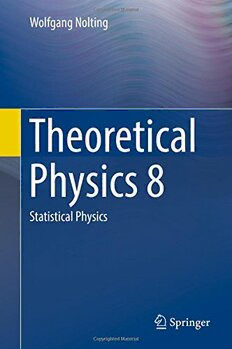Table Of ContentWolfgang Nolting
Theoretical
Physics 8
Statistical Physics
Theoretical Physics 8
Wolfgang Nolting
Theoretical Physics 8
Statistical Physics
123
WolfgangNolting
InstituteofPhysics
Humboldt-UniversityatBerlin
Germany
ISBN978-3-319-73826-0 ISBN978-3-319-73827-7 (eBook)
https://doi.org/10.1007/978-3-319-73827-7
LibraryofCongressControlNumber:2016943655
©SpringerInternationalPublishingAG2018
Thisworkissubjecttocopyright.AllrightsarereservedbythePublisher,whetherthewholeorpartof
thematerialisconcerned,specificallytherightsoftranslation,reprinting,reuseofillustrations,recitation,
broadcasting,reproductiononmicrofilmsorinanyotherphysicalway,andtransmissionorinformation
storageandretrieval,electronicadaptation,computersoftware,orbysimilarordissimilarmethodology
nowknownorhereafterdeveloped.
Theuseofgeneraldescriptivenames,registerednames,trademarks,servicemarks,etc.inthispublication
doesnotimply,evenintheabsenceofaspecificstatement,thatsuchnamesareexemptfromtherelevant
protectivelawsandregulationsandthereforefreeforgeneraluse.
Thepublisher,theauthorsandtheeditorsaresafetoassumethattheadviceandinformationinthisbook
arebelievedtobetrueandaccurateatthedateofpublication.Neitherthepublishernortheauthorsor
theeditorsgiveawarranty,expressorimplied,withrespecttothematerialcontainedhereinorforany
errorsoromissionsthatmayhavebeenmade.Thepublisherremainsneutralwithregardtojurisdictional
claimsinpublishedmapsandinstitutionalaffiliations.
Printedonacid-freepaper
ThisSpringerimprintispublishedbySpringerNature
TheregisteredcompanyisSpringerInternationalPublishingAG
Theregisteredcompanyaddressis:Gewerbestrasse11,6330Cham,Switzerland
General Preface
TheninevolumesoftheseriesBasicCourse:TheoreticalPhysicsarethoughttobe
textbookmaterialforthestudyofuniversity-levelphysics.Theyareaimedtoimpart,
in a compact form, the most important skills of theoretical physics which can be
usedasbasisforhandlingmoresophisticatedtopicsandproblemsintheadvanced
study of physics as well as in the subsequent physics research. The conceptual
designofthepresentationisorganizedinsuchawaythat
ClassicalMechanics(volume1)
AnalyticalMechanics(volume2)
Electrodynamics(volume3)
SpecialTheoryofRelativity(volume4)
Thermodynamics(volume5)
are considered as the theory part of an integrated course of experimental and
theoretical physics as is being offered at many universities starting from the first
semester.Therefore,thepresentationisconsciouslychosentobeveryelaborateand
self-contained,sometimessurelyatthe costofcertainelegance,sothatthecourse
is suitableevenforself-study,at firstwithoutanyneedof secondaryliterature.At
anystage,nomaterialisusedwhichhasnotbeendealtwithearlierinthetext.This
holds in particular for the mathematical tools, which have been comprehensively
developed starting from the school level, of course more or less in the form of
recipes,suchthatrightfromthebeginningofthestudy,onecansolveproblemsin
theoreticalphysics. The mathematicalinsertionsare always then pluggedin when
theybecomeindispensabletoproceedfurtherintheprogramoftheoreticalphysics.
It goes without saying that in such a context, not all the mathematical statements
canbeprovedandderivedwithabsoluterigor.Instead,sometimesareferencemust
be made to an appropriate course in mathematics or to an advanced textbook in
mathematics. Nevertheless, I have tried for a reasonably balanced representation
so that the mathematical tools are not only applicable but also appear at least
‘plausible’.
v
vi GeneralPreface
The mathematical interludes are of course necessary only in the first volumes
of this series, which incorporatemore or less the material of a bachelor program.
InthesecondpartoftheserieswhichcomprisesthemodernaspectsofTheoretical
Physics,
QuantumMechanics:Basics(volume6)
QuantumMechanics:MethodsandApplications(volume7)
StatisticalPhysics(volume8)
Many-BodyTheory(volume9),
mathematical insertionsare no longer necessary. This is partly because, by the
time one comes to this stage, the obligatory mathematics courses one has to take
in order to study physics would have provided the required tools. The fact that
training in theory has already started in the first semester itself permits inclusion
ofpartsofquantummechanicsandstatisticalphysicsinthebachelorprogramitself.
Itisclearthatthecontentofthelastthreevolumescannotbepartofanintegrated
coursebutratherthesubjectmatterofpuretheorylectures.Thisholdsinparticular
forMany-BodyTheorywhichisoffered,sometimesunderdifferentnamesas,e.g.,
AdvancedQuantumMechanics,intheeighthorsosemesterofstudy.Inthispartnew
methodsandconceptsbeyondbasicstudiesareintroducedanddiscussed,whichare
developedinparticularforcorrelatedmanyparticlesystemswhichinthemeantime
havebecomeindispensablefora studentpursuingmaster’sora higherdegreeand
forbeingabletoreadcurrentresearchliterature.
In all the volumes of the series Basic Course: Theoretical Physics numerous
exercisesareincludedtodeepentheunderstandingandtohelpcorrectlyapplythe
abstractlyacquiredknowledge.Itisobligatoryforastudenttoattemptonhisown
to adapt and apply the abstract concepts of theoretical physics to solve realistic
problems.Detailed solutionsto the exercisesare givenat the endof eachvolume.
The idea is to help a student to overcomeany difficulty at a particular step of the
solutionortocheckone’sowneffort.Importantlythesesolutionsshouldnotseduce
thestudenttofollowtheeasywayoutasasubstituteforhisowneffort.Attheend
ofeachbiggerchapterIhaveaddedself-examinationquestionswhichshallserveas
aself-testandmaybeusefulwhilepreparingforexaminations.
Ishouldnotforgettothankallthepeoplewhohavecontributedonewayorother
to the success of the book series. The single volumes arose mainly from lectures
that I gave at the universities of Muenster, Wuerzburg, Osnabrueck, and Berlin
(Germany),Valladolid(Spain),andWarangal(India).Theinterestandconstructive
criticismofthestudentsprovidedmethedecisivemotivationforpreparingtherather
extensivemanuscripts.AfterthepublicationoftheGermanversionIreceivedalot
ofsuggestionsfromnumerouscolleaguesforimprovementandthishelpedtofurther
develop and enhance the concept and the performance of the series. In particular
I appreciate very much the support by Prof. Dr. A. Ramakanth, a long-standing
scientificpartnerandfriend,whohelpedmeinmanyrespects,e.g.,whatconcerns
thecheckingofthetranslationoftheGermantextintothepresentEnglishversion.
GeneralPreface vii
SpecialthanksareduetotheSpringercompany,inparticulartoDr.Th.Schneider
and his team. I remember many useful motivations and stimulations. I have the
feelingthatmybooksarewelltakencareof.
Berlin,Germany WolfgangNolting
December2017
Preface to Volume 8
IntheprefacesoftheprecedingvolumesIhavealreadysetoutthegoalofthebasic
course in Theoretical Physics. This goal, explained and justified in the General
Preface, remains of course unchangedfor the present eighth volume of the series
onStatisticalPhysicsalso.
The Statistical Physics represents in almost all courses of study on physics
the closure of the basic education in Theoretical Physics and is offered, as a
rule, in the sixth semester, at least when the training in Theoretical Physics starts
already in the first semester. It belongs, besides Quantum Mechanics (Vols. 6
and 7), to the modern disciplines of Theoretical Physics, whose understanding is
mandatory either in elementary form for the bachelor program or in an advanced
version for the master program. In contrast, Classical and Analytical Mechanics
(Vols.1and2),Electrodynamics(Vol.3),SpecialTheoryofRelativity(Vol.4),and
Thermodynamics (Vol. 5) are ascribed to the classical disciplines. Normally they
arepartsofthebachelorprograminthecourseofstudyonphysics.
The underlying volume on Statistical Physics is subdivided into four larger
chapters.Inthefirstchapter,themostimportantconceptsandmethodsforclassical
systems are explained and exercised. It is demonstrated how the large number
of degrees of freedom of macroscopic systems can lead to completely novel
phenomena.Asanexampleitmaybementionedheretheirreversibletransitionof
athermodynamicsystemintoequilibrium,which,althoughactuallyallmicroscopic
equations of motion are time-reversal invariant, has to, as everyday observation,
beacceptedandunderstood.TheMethodofStatisticalEnsembles(microcanonical,
canonical,grandcanonical)turnsouttobeasuccessfulapproachforthedescription
of macroscopic physical systems. The proof of the equivalence of these three
ensemblesisanimportantsubjectofthefirstchapter.
The second chapter deals with Quantum Statistics. A double indeterminacy is
characteristicofit,whichrequirestwoaveragingprocessesofcompletelydifferent
nature.Besides the indeterminacydue to the large numberof degreesof freedom,
whichis ofcoursepresentalso forclassical systems, thereappearsthe principally
unavoidable quantum-mechanical uncertainty (measurement process!). This fact
necessitatesthedevelopmentofgenuinequantum-statisticalconcepts.
ix
x PrefacetoVolume8
A firstimportantapplicationof the generaltheoryconcernstheIdealQuantum
GasesinChap.3,forwhichthequantum-mechanicalPrincipleofIndistinguishabil-
ityofIdenticalParticlesplaysanextraordinaryrole.SystemsofidenticalFermions
and systems of identical Bosonsunderliedifferentphysicalprinciples, which lead
to physicalbehaviorsstrongly deviating from one another. As a further important
applicationoftheStatisticalPhysicsIhavechosenthehighlytopicalbranchofthe
PhaseTransitionsandCriticalPhenomenainChap.4.
This volume on Statistical Physics arose from lectures I gave at the German
universitiesinWürzburg,Münster,andBerlin.Theanimatinginterestofthestudents
inmylecturenoteshasinducedmetopreparethetextwithspecialcare.Thepresent
oneaswellastheothervolumesarethoughttobethetextbookmaterialforthestudy
ofbasicphysics,primarilyintendedforthestudentsratherthanfortheteachers.
I am thankful to the Springer company, especially to Dr. Th. Schneider, for
acceptingandsupportingtheconceptofmyproposal.Thecollaborationwasalways
delightfulandveryprofessional.Adecisivecontributiontothebookwasprovided
by Prof. Dr. A. Ramakanth from the Kakatiya University of Warangal (India), a
long-standingscientificpartnerandfriend,whohelpedmeinmanyrespects.Many
thanksforit!
Berlin,Germany WolfgangNolting
December2017
Contents
1 ClassicalStatisticalPhysics................................................. 1
1.1 Preparations ............................................................. 1
1.1.1 FormulationoftheProblem................................... 1
1.1.2 SimpleModelSystem......................................... 3
1.1.3 Exercises....................................................... 10
1.2 Micro-CanonicalEnsemble............................................. 11
1.2.1 State,PhaseSpace,TimeAverage............................ 11
1.2.2 StatisticalEnsemble,EnsembleAverage..................... 16
1.2.3 LiouvilleEquation............................................. 18
1.2.4 Micro-CanonicalEnsemble................................... 22
1.2.5 Exercises....................................................... 26
1.3 ConnectiontoThermodynamics ....................................... 28
1.3.1 ConsiderationsonThermalEquilibrium..................... 28
1.3.2 EntropyandTemperature..................................... 35
1.3.3 SecondLawofThermodynamics............................. 41
1.3.4 ChemicalPotential ............................................ 43
1.3.5 BasicRelationofThermodynamics.......................... 45
1.3.6 EquipartitionTheorem........................................ 49
1.3.7 IdealGas....................................................... 51
1.3.8 Exercises....................................................... 57
1.4 CanonicalEnsemble .................................................... 60
1.4.1 PartitionFunction ............................................. 61
1.4.2 FreeEnergy.................................................... 65
1.4.3 Fluctuations.................................................... 68
1.4.4 EquivalenceofMicro-CanonicalandCanonical
Ensemble....................................................... 69
1.4.5 Exercises....................................................... 72
1.5 Grand-CanonicalEnsemble ............................................ 77
1.5.1 Grand-CanonicalPartitionFunction.......................... 78
1.5.2 ConnectiontoThermodynamics.............................. 81
xi

